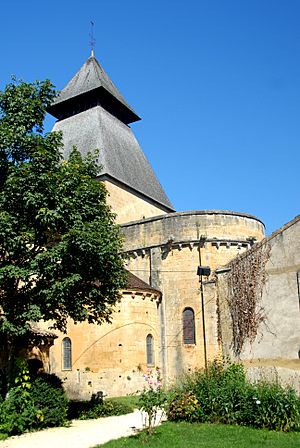Cadouin Abbey facts for kids
Cadouin Abbey (which is Abbaye Notre-Dame de la Nativité de Cadouin in French) was a special kind of monastery. It was started in 1115 as a quiet place for monks, like a hermitage. It was founded by a person named Gerald of Salles in a town now called Le Buisson-de-Cadouin in south-west France.
In 1119, Cadouin became a full abbey. Its first leader was Henri, a monk from another important abbey called Pontigny Abbey. Cadouin Abbey became part of the Cistercian Order, a group of monasteries, around the year 1199.
Cadouin Abbey even started its own new monasteries, like Grandselve Abbey and Bonnevaux Abbey. These also became Cistercian monasteries over time.
At some point, the abbey got hold of something very special: a cloth believed to be the facecloth from the tomb of Jesus. It was called le Saint-Suaire de Cadouin in French. People said it was brought from a place called Antioch. This special cloth made Cadouin Abbey a very important place for pilgrimage (a journey to a holy place). Many people came to see it, which brought the abbey a lot of fame and money.
Cadouin was also close to one of the main paths of the Way of Saint James, a famous pilgrimage route. However, big wars in the 13th and 14th centuries meant fewer people could travel, and the number of pilgrimages went down a lot.
In 1791, during the French Revolution, the abbey was closed down. By then, only four monks lived there. The abbey's valuable things were taken, and its library, full of books, was sadly burned in the village square.
Today, the main church of the abbey is still standing and can be visited.
See also
 In Spanish: Abadía de Cadouin para niños
In Spanish: Abadía de Cadouin para niños


